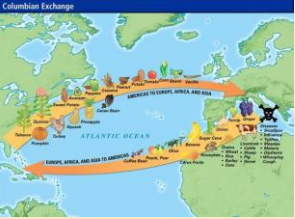Source:Brisbane 4EB Sri Lankan Newsletter – Dæhæna – October 2021
Colombian exchange is the anthropological term describing the exchange of produce between the New World (Americas and the Caribbean) and the Old World. This trade was primarily facilitated by the first exploration of Portuguese and Spanish seafarers who not only introduced the fruits and vegetables to their native lands, but also across their colonies. The Columbian Exchange has played an integral role in sculpting the culinary landscape of Sri Lanka. Many fruits and vegetables believed to be quintessentially Sri Lankan have their roots in the Americas. The following are a small sample of the vast number of edible items introduced to Sri Lanka from the Americas:
Fruits: Avocado, Chilli Peppers, Guava, Papaya, Passion Fruit, Pine
apple, Tomatoes
Vegetables: Corn, Manioc, Potatoes, Pumpkin, Sweet Potatoes
Nuts: Brazil Nuts, Cashew, Peanuts, Pecans
Beans: Kidney, Lima, Navy
Others: Cacao (Chocolate), Coriander, Vanilla, Tobacco, Rubber

The aforementioned items are now an integral part of Sri Lankan food and gastronomy. Many of us take a pride in the exceptional quality of Sri Lankan fruits and have been raised on vivid memories of biting into juicy pineapples,
ripe guava, and fragrant fried cashews. The quintessential Sri Lanka breakfast features ‘ala hodi’ (potato curry) and fiery lunch time curries like ‘maalu mirisata’ (fish curry) rely entirely on fragrant chillies for their characteristic burn.Generations of Sri Lankans may recall labouring over a steaming pot of ‘kothamalli’ (coriander), the universal remedy for respiratory illnesses prescribed by Sri Lankan parents. Many of us have indulged in a richly flavoured bar of chocolate or have become familiar with the astringent and earthy whiff of tobacco in a ‘bulath wita’ (betel), whilst being entirely unaware of the non-native origins of these foods. Enjoyment of these sensory delicacies often occurs without an appreciation of the vast exchange of Native American and Caribbean produce brought to Sri Lanka by Portuguese and other seafarers. These seafarers, many of whom settled and intermarried into the Sri Lankan community integrated these goods into local cuisine, leaving us as the proud beneficiaries of cashew and pineapple curries. In our experience, an understanding of this fascinating part of Sri Lankan history is likely to heighten and render our food experiences richer and more fulfilling. An appreciation of these influences will
facilitate nuanced discussions about the delicately interwoven web of influences that characterise the culinary history of our little island and its eminence in global trade networks.
Randika Jayakody and Jerome Perera
Among Randika and Jerome’s many interests is a
deep passion to understand Sri Lankan history and
culture. This has been facilitated through exposure to
multiculturalism through their travels and living
experiences in multiple countries.






